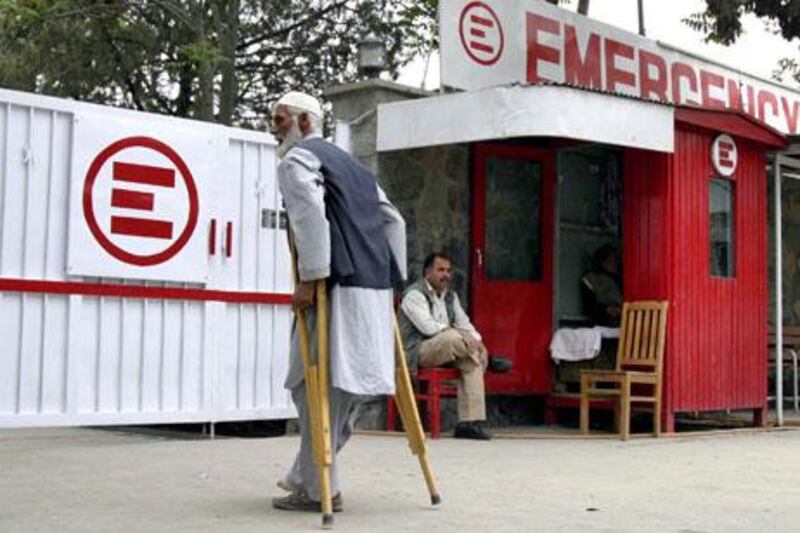KABUL // Four-year-old Fauzia was admitted to Kabul's Emergency Hospital with a Kalashnikov bullet lodged in her brain. Struck during a recent firefight between the Taliban and Nato forces in her native province of Ghazni, she may never gain full control of the right side of her body, and is now having trouble speaking.
Fauzia is just one of a growing number of war wounded patients currently being treated at Kabul's Emergency Hospital. For years just a general trauma centre run by an Italian charity, the hospital, overwhelmed by the rising number of casualties, recently converted itself into a facility strictly for the war wounded.
As the conflict between Taliban fighters and US-led forces intensifies - and the anti-government insurgency creeps closer to the capital - the hospital's transformation tells the story of Afghanistan's rapid descent into violence, particularly in the provinces around Kabul.
According to a September report released by the Afghan NGO Security Organisation (Anso), a group that tracks insurgent attacks and violence against aid workers in Afghanistan, the provinces of Wardak, Ghazni, Logar and Paktia - all bordering or close to the capital and served by the Emergency Hospital - saw a marked increase in violence in the first nine months of the year.
Anso says the insurgency in Afghanistan is gaining strength and new recruits in areas where the Taliban has not previously been prominent, and that insurgent attacks are up 59 per cent compared to last year.
Emergency Hospital's patient statistics reflect the upsurge. Antonio Rainone, the hospital's surgeon-general says they admitted twice as many patients with war injuries in August as they did in January, with civilians coming in from provinces around Kabul with wounds from bullets, mortar shells and shrapnel from rockets. They admit an average of 200 patients per month, or about six new patients each day.
With at least 1,200 civilians killed in Afghanistan in the first six months of 2010, according to the United Nations, this year is proving to be the deadliest so far for both Afghan civilians and foreign troops since the US invasion in 2001.
"There were more and more war injuries coming in from the provinces around Kabul, where security appears to be getting worse," Dr Rainone said. "With our limited resources [the hospital has only two operating beds] we decided we would need to start treating only war injuries. And we were right: so far, the hospital remains full."
Lying next to Fauzia in the hospital's sub-intensive ward is Anib, a 10-year-old boy from Logar with pieces of a stray mortar round piercing his skull.
Across from Anib is 31-year-old Mohammadeen, also from Logar. His body was sprayed with shrapnel after an improvised explosive device - Taliban insurgents' weapon of choice - exploded under his vehicle on a road last month.
"Logar is so much worse than it was two years ago," said Mohammadeen, wincing in pain as he moves what remains of his right leg, shattered by the blast, across the hospital bed. "There are explosions every day now, especially on the roads. I tell my family to stay home."
An Afghan surgeon, Aziz Rahman, who heads the hospital's sub-intensive ward, says he has seen more war injuries this year than in the eight years he has worked at the hospital. Most of his patients have been operated on in the past six months, he says, and come from Logar, but also Wardak, Ghazni and Paktia, bordering Pakistan to the east.
One senior US military adviser, speaking on background, said military intelligence suggests Taliban fighters are implementing a plan to encircle the capital, and are carrying out attacks in places out of their normal theatre of operations in the east and the south.
Dr Rainone says he can use patients to track growing trends in violence, but finds it much harder to detect whether the wounds are from weapons used by the insurgency or foreign forces, and whether or not the civilians were targeted deliberately or caught in the crossfire.
"Often, what the patients say does not correspond to the truth, and it's an invasion of their lives to ask," he says. "They often don't know what happened or where the bomb came from, or they're too scared to say. That's the nature of war."
The UN says most of the civilians killed in the war this year were by the insurgency, but international forces have also come under fire for killing civilians in errant air strikes.
"We just walked out of the house to go visit another family, and we were hit," says Fauzia's father, 25-year-old Habib. His wife was also shot in the leg.
Dr Rainone says Emergency Hospital will most likely remain a war hospital for years to come.
"The Afghans, they miss security," he says. "They have forgotten what it is like to live in security."





